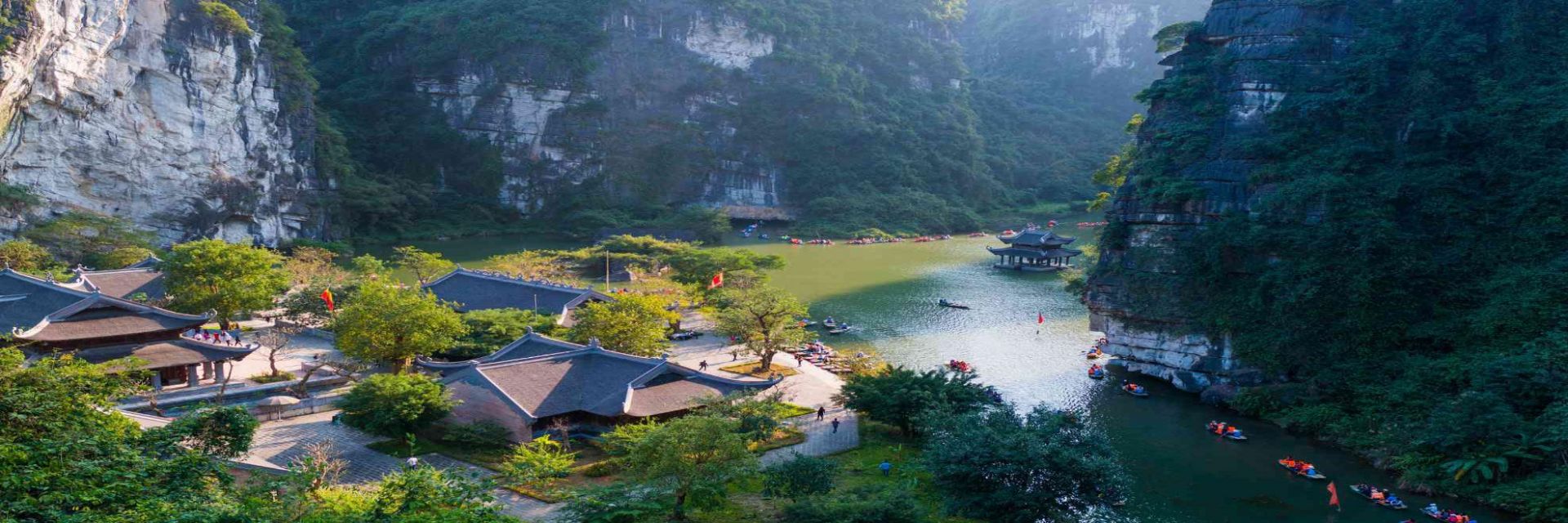Introduction to Trang An Ninh Binh
Trang An Eco-tourism Site is part of the Trang An Scenic Landscape Complex, situated in Ninh Binh Province, 90 kilometers south of Hanoi. The site covers over 2,000 hectares and comprises a network of waterways, limestone karsts, and caves.
Trang An Vietnam features a 250-million-year-old geological system of limestone mountains with diverse ecosystems, including flooded forests, limestone mountains, and archaeological and cultural relics. Emperor Đinh Tiên Hoàng chose Trang An as the southern protective barrier for the imperial capital of Hoa Lu in the 10th century. Later, during the resistance against the Yuan Dynasty, the Trần Dynasty used it as the Vu Lam Palace. The site still retains many historical relics from the Dinh and Tran dynasties.
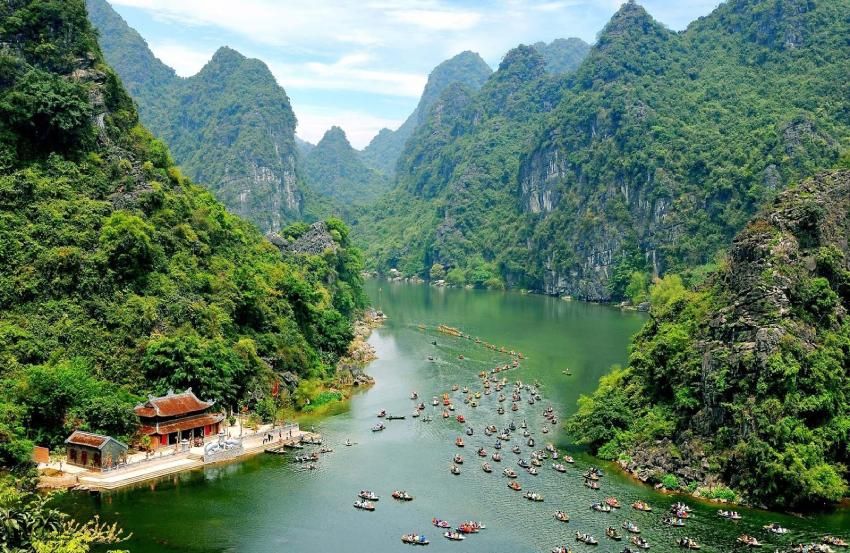
It is renowned for its striking natural beauty, including towering limestone cliffs, verdant forests, and pristine rivers. Moreover, Trang An caves enchant visitors with its beauty of magnificent stalactite formations. It attracts a considerable number of both domestic and international visitors. In 2014, Trang An Eco-tourism Complex was also recognized as a UNESCO World Heritage Site for its natural and cultural significance.
When is the best time to visit Trang An Ninh Binh?
Trang An Ninh Binh offers something fascinating to explore in every season, adorning itself with a new coat of beauty.
In spring, visitors can participate in unique festivals like the Trang An Festival (in the middle of the third lunar month) and the Co Lau Festival (from the 8th to the 10th day of the third lunar month). In summer, the enchanting golden rice fields and fragrant lotus ponds are a sight to behold. When fall arrives, the weather becomes pleasant and cool, making it perfect for outdoor activities. And in winter, Trang An transforms into a misty fairyland, adding to its charm.

Trang An Ninh Binh Vietnam is a destination worth visiting year-round with something special to offer in every season.
Travel routes in Trang An
The main typology in Trang An is rivers, therefore, in the process of traveling to Trang An, your main means of transportation is a boat. One boat can carry about 4 adults and the ferryman can act as a temporary guide for you as they know the locations very well. If you want to learn more, don't hesitate to talk to them.
Traveling by boat in Trang An has 3 routes for you to choose:
- Route 1: Boat Wharf – Trinh Temple – Dark Cave – Morning Cave – Ruou Cave – Tran Temple – Ba Giot Cave – Seo Cave – Son Duong Cave – Phu Khong – Bao Hieu Pagoda – Khong Cave – Tran Cave – Quy Hau Cave – Return to the boat wharf (time: 3.5 hours)
- Route 2: Boat wharf – Lam Cave – Vang Cave – Thanh Slide Cave – Suoi Tien Temple – Dai Cave – Vu Lam Hanh Cung – return to the boat wharf (time: 2.5 hours)
- Route 3: Boat wharf – Trinh Temple – Cloud Cave – Suoi Tien – Dia Linh Cave – Dai Cave – Vu Lam Hanh Cung – return to the boat wharf (time: 3 hours)
Some attractive places in Trang An
Coming Trang An, visitors will be sitting on a boat floating in the middle of thousands of rivers. There is nothing more wonderful than sitting on a boat and going through 12 mysterious caves and watching the spectacular and beautiful Ninh Binh mountains.
Cultural sites
Coming to Trang An, visitors must visit spiritual sites containing great cultural values. Those are the temples located right in the eco-tourism area such as Trinh Temple, Tran Ninh Binh Temple, Tu Tru Temple, Cao Son Temple, Suoi Tien Temple, Vu Lam Palace, Phu Khong...
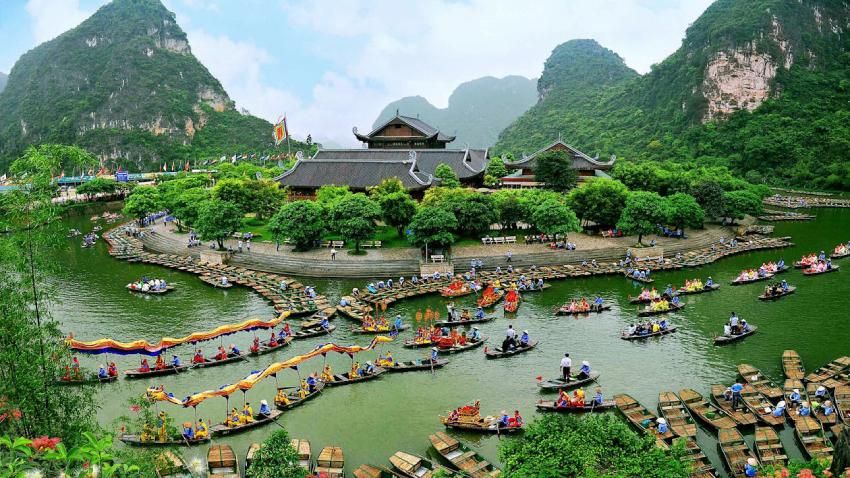
Trinh Temple
The temple is the place to worship 4 gods of the Dinh Dynasty. These are the generals who govern the king's gold and silver vaults. It is said that, after King Dinh Tien died, 4 generals brought Dinh Toan to hide in this place to avoid the pursuit of Le Hoan. And when King Le Hoan ascended the throne, because of disobedience, they killed themselves here. Therefore, the temple of 4 generals was established.
Tran Temple
Tran Temple is the place to worship the god Quy Minh, who is the god of the Hoa Lu town in the south. This is the temple established by King Dinh Tien Hoang. However, when King Tran Thai Tong acceded, he renovated the temple and renamed it Tran Temple.
Khong Temple
Khong temple is located in a very favorable position with its back leaning against the cave, in front of it is a valley of clear blue water in the silhouette of mountains and clouds. This is the place to worship 7 loyal officials of the Dinh dynasty. Right at the temple, there is a thousand-year-old Thi tree with 2 types of fruit: round type and flat type.
The film studio of 'Kong: Skull Island'
Kong: Skull Island is an American blockbuster filmed in 2016 with many scenes shot at famous landmarks of Vietnam such as Trang An World Heritage Complex, Van Long Nature Reserve, Tam Coc - Bich Dong (Ninh Bình); Ha Long Bay (Quang Ninh) and Phong Nha (Quang Binh).
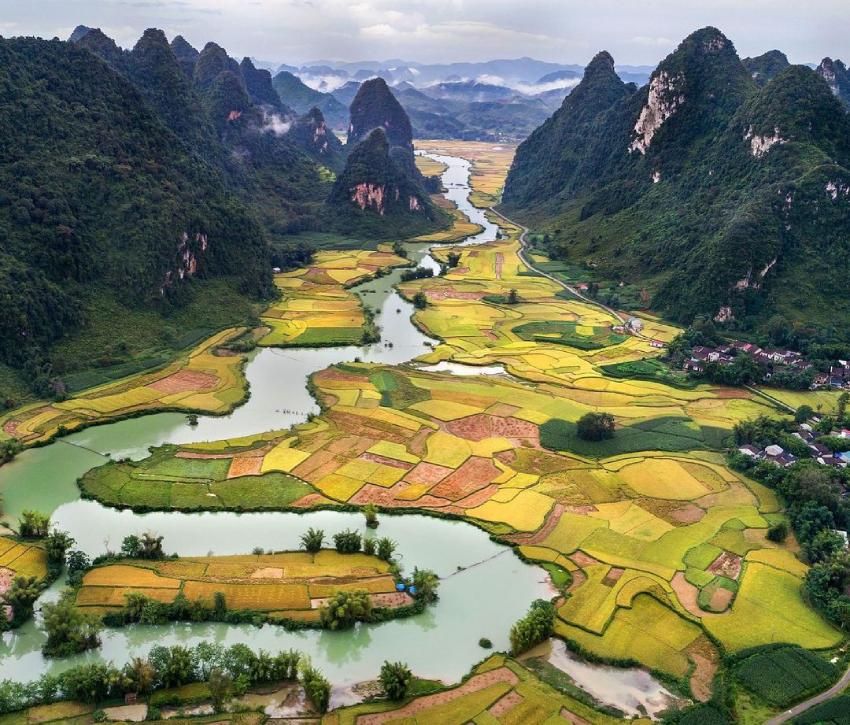
The Aboriginal village studio is restored with an area of about 10 hectares, including 36 pointed huts with the participation of more than 50 people playing Aboriginal roles. This is a model implemented by Trang An Ecological Management Board and Xuan Truong Enterprise. The scene of the aboriginal village film studio in the movie Kong: Skull Island located in Trang An tourist area has been open to visitors since April 15, 2017.
Cao Son Temple
Cao Son Temple worships Cao Son God who takes care of the West of Hoa Lu town. According to the genealogy of Cao Son temples in Ninh Binh, Cao Son King was Lac Tuong Vu Lam (that is the mountains in the west of Ninh Binh today, so it is also known as the western god of Hoa Lu town), the 17th son of King Lac Long Quan, when obeying his king's orders (the first Hung Vuong) to patrol from Nam Linh area to Thien Duong area, found a species of tree with powdery roots used to make cakes instead of rice flour, then using his name to name the tree, it's Quang Lang (local people still call it Quang Lang or Bung Bang tree). He has taught and helped people make a living and protect them from destructive forces, so people have built many temples.
Suoi Tien Temple
Suoi Tien Temple is located upstream of the Ngo Dong River, which is actually an extension of the Tam Coc tourist route but is connected to the second tourist route in the Trang An eco-tourism area. Temple worships Quy Minh God, the Southern God of Hoa Lu town.
What to eat in Trang An eco-tourism area?
To talk about specialties in Ninh Binh in general and Trang An in particular, there are many delicious specialties that visitors coming to Trang An definitely cannot ignore.
Ninh Binh burnt rice
Because it is a famous specialty, you can buy burnt rice anywhere when coming to Trang An. Don't forget to buy some burnt rice to take home as a gift
Mountain goat meat
Mountain goat meat is one of the specialties that tourists cannot ignore when coming to Ninh Binh. Goats are raised freely and run around on the rocky mountains in Ninh Binh, so the meat is firm and fresh. Mountain goat meat can be processed into many different dishes such as goat spring rolls, grilled goat, steamed goat, goat with sesame sauce, goat hot pot, or rare goat with lemon...
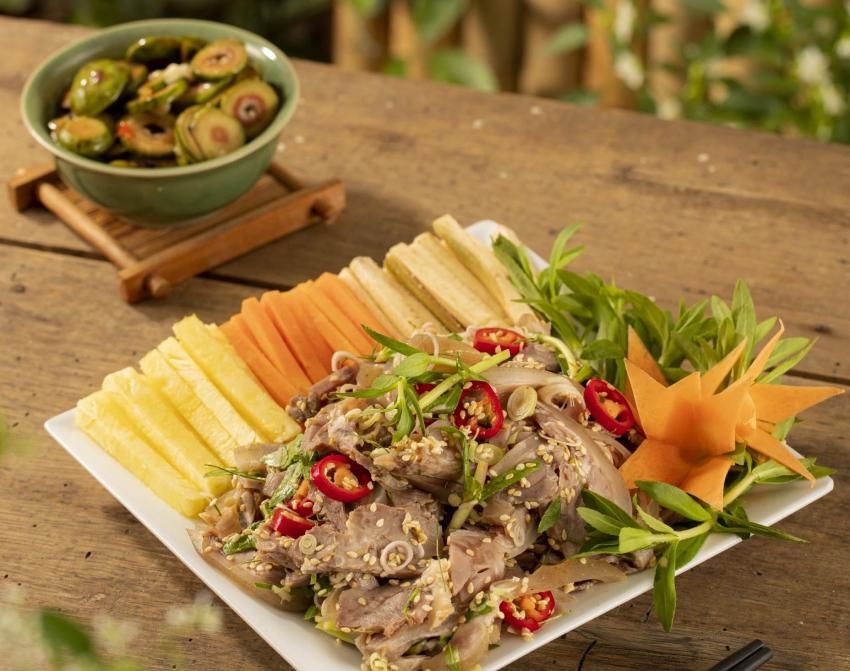
Sticky rice with ant eggs
Sticky rice with ant eggs is also considered one of the specialties that visitors must enjoy when traveling to Trang An. Ant eggs here are brown ant eggs. After being cleaned, fry fragrantly with dried onion and chicken fat, ant eggs will be mixed well into hot sticky rice. The greasy ant eggs combined with the sticky rice and the sweet aroma of fried onions create a unique dish.
Ninh Binh mountain snail
Mountain snails are not like ordinary snails, because they live in the mountains and eat wild grasses, including precious medicinal plants. Mountain snails have high nutritional value and can be used as medicine to treat joint pain, rheumatism, or stomach. Mountain snails are also processed into many special dishes such as boiled snails, grilled snails, fried snails with tamarind, and steamed snails with ginger.



